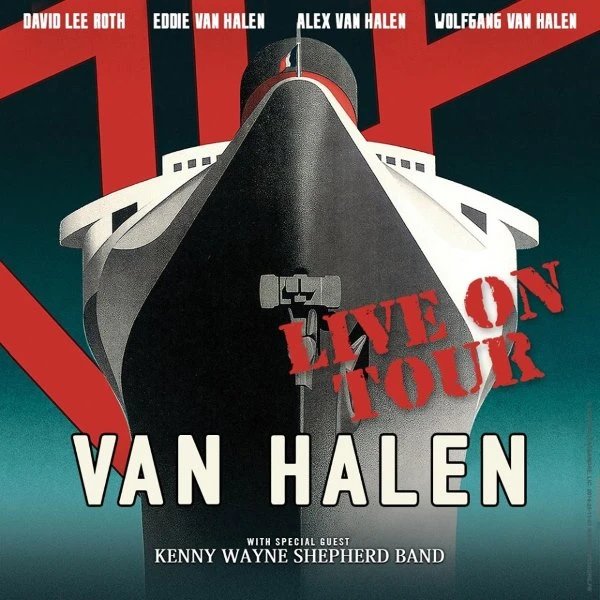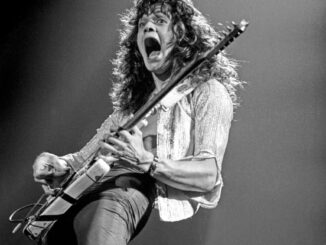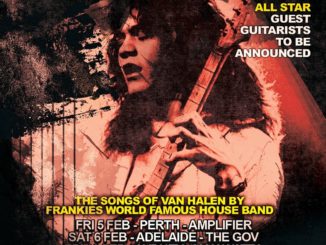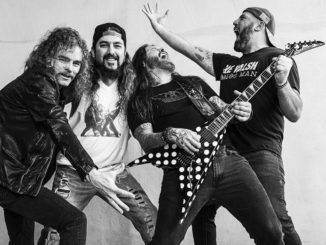
To date, Van Halen have been notoriously selective about releasing official live material. In 1987, they released Live Without a Net, a video of a 1986 show featuring mostly material written with then-lead singer Sammy Hagar. A few years later came Live: Right Here, Right Now (1993), a compilation of two shows in 1992 that skews heavily in favor of 1991’s For Unlawful Carnal Knowledge and contains ten of its eleven tracks (only the 1:28 acoustic instrumental “316” is left off). Since Live: Right Here, Right Now has twenty-four tracks, you really need to be a fan of For Unlawful Carnal Knowledge. In fact, you had better be a big fan of the so-called Van Hagar version of Van Halen because live versions of tracks from original singer David Lee Roth’s time are few and far between. Live Without a Net features only two songs first recorded with Roth (“Panama” and “Ain’t Talkin’ ‘Bout Love”) and Live: Right Here, Right Now has only three (“Panama,” “Ain’t Talkin’ ‘Bout Love,” and “Jump”) unless you count the cover of “You Really Got Me” performed on Van Halen’s debut. Van Halen fans have been practically starved for live releases and Roth-era songs are at a high premium. Prior to 2015, there was no live material officially issued with Roth singing, so the best you could do was listen to the smattering of Roth songs with Hagar singing.
Some of that is because Roth split from Van Halen in 1985 and aside from a very brief reunion in 1996 that yielded two new songs for a Best Of album and a rumored 2001 reunion that yielded nothing, Roth stayed separated from Van Halen until 2007. The reunited Van Halen recorded one more studio album, A Different Kind of Truth (2012).
The Washington Times has a 2015 interview with Eddie Van Halen in which he explains that a live album was not their first choice for a 2015 release. The first choice was a new studio album, but “We didn’t have time to put a studio record together.” The second choice was to “remix the original 25 song demos . . . But the tapes are lost.” The third choice was to put out some “bootlegs from the club days.” They tried their “best to make those sound good, but ultimately it wasn’t good enough to put out.” A recent live show, then, seems to have been the next option.
Recorded in 2013, Tokyo Dome Live in Concert (2015) finally gave fans not just a long-awaited new live release, but a live release featuring songs exclusively from the Roth-fronted Van Halen and with Roth himself singing them. We get material from all six of the first Van Halen albums as well as just enough from A Different Kind of Truth. Van Halen completely cut out the Hagar years, which is not surprising given all the bickering and sniping both sides have engaged in over the years—the upside is you get mostly tunes you haven’t heard before on a live Van Halen album. The Tokyo performance is captured in its entirety and unedited. Bob Clearmountain mixed it and that’s all the work that was reportedly done on it. In a 2015 interview with Guitar World Eddie said, “We did nothing” in terms of editing or altering the recorded performance.
In that same interview Eddie talks about the album. He said they had an extensive archive of shows—about 150—to draw from since they had recorded every live show with Roth since the beginning of the 2007 tour with Roth. Since the setlists were more or less the same and the instrumental performances were consistent and “performing live is a lot harder on a singer,” the band thought Roth should pick the show to put out. Eddie says that Roth “happened to pick Tokyo,” but we receive no further explanation. In fact, vhlinks.com has a three-page thread pondering Roth’s silence titled “No DLR Press for VH Live At Tokyo Dome?” Why Roth picked this exact show is unknown. The answer may be as simple as Roth is proud of his performance that particular night. In a February 12, 2013 interview with Rolling Stone, Roth speaks of his deep connection to Japan where has a home, studies Japanese, takes classes in Japanese, and conducts a Japanese radio show. A 2018 Vogue article reports that he sat for 300 hours getting tattooed with “the whole Japanese tuxedo: kabuki faces, the original showbiz, rendered Edo style.” This man is into Japan. My theory is he picked the Tokyo show because of his affinity with Japan and just felt good about it.
Eddie also reports that “Bob kept sending us mixes and we just said, ‘It sounds good to us!’ As long as we could hear all the instruments it was good!” We can read that laid-back approach coupled with the decision to let Roth pick the performance two different ways. The thinking could have been if we go through and listen to every recorded show from 2007, start mixing and matching parts of different performances together, and/or start redoing parts in the studio, we’re going to get bogged down. We’ve already been down that road, at least partially, with Live: Right Here, Right Now. Let’s try the opposite approach this time, and make it as live as possible. No particular show stands out to us, so let Roth pick a show that we will release unedited in its entirety. Very simple. This gives Roth gives major input at the start, and avoids potential arguments later. Get somebody to give it a decent mix so that everybody can be heard, put it out, and let’s move on.
It’s also possible Van Halen, or some members of them, wanted to get some sort of product out on the market (as we know), recent live work was a fourth choice (as we know), and didn’t particularly care much from there about it. If Van Halen just wanted to toss something out there, Tokyo Dome accomplishes that. I kind of doubt they just wanted to rush a show, any show, out to the market given how much they, especially Eddie, have historically cared about their music. Remember that according to Eddie, they could have released the enhanced bootlegs but held them back because of quality control. Remember, too, this is Roth’s first live album—and not just with Van Halen. This is his first live album ever. Surely, that meant something to him.
Roth is also credited in the liner notes with “Design Concept,” so he had another level of involvement in the release besides just picking which show to feature. The packaging is appealing and as the Van Halen News Desk website explains, “There were two songs where Dave sang completely different lyrics in spots, so the proper, unsung lyrics are shown in red to differentiate from what was sung.” That demonstrates attention to detail, so it seems Van Halen cared about this release. Tokyo Dome appears to be the product of a clear and fair division of labor in the Van Halen camp and a focus on meaningful and defined priorities. Perhaps the 2.0 version of the Roth-fronted Van Halen had the wisdom to avoid creating the conditions for possible power struggles and to avoid overthinking things.
What the fans really know and care about is that at long last a Van Halen live album with Roth was finally—finally—appearing.
So how does it sound? Does it rock? It sounds good. It sounds live. And it rocks. You get lots of quirky stage raps, little jams, extension, bits of other songs like Deep Purple’s “Smoke on the Water” mixed in, and cool surprises like Van Halen briefly and suddenly transforming into a salsa band on “Me & You.” It’s refreshing to hear these songs sound different from the standard versions we’ve heard on the formal releases and classic rock stations for years and years. Eddie shreds. Alex Van Halen powers the drums. Eddie’s son Wolfgang replaced founding bassist and backup vocalist Michael Anthony. Wolfgang seems to do a fine job of playing bass, locking in with Uncle Alex, and working the groove. Eddie reports that “Wolfgang and I sing backup vocals on the choruses.” However, the backup vocals approximate but do not always duplicate what Anthony was capable of giving (though some songs are closer than others). He is an integral part of Van Halen’s sound instrumentally and vocally. This change calls more attention to Roth’s vocals. If there is a weak link on the album, it is Roth. The range, tone, and power of his voice have changed. His voice doesn’t sound thin or strained so much as weathered from the years of singing, shrieking, yelping, moaning, wailing, bright spandex cutting off his circulation, touring, and who knows what else going on backstage. He’s not bad on Tokyo Dome; he’s simply not as good as he once was. On occasion, a note catches him or he pushes for something he can’t quite get to or hold as long as he once did. Other times, he recaptures that excellent, earlier version of himself. Most of the time he sounds at least okay, if not good (and never awful). He pierces without always penetrating. He may not shatter glass, but he still makes it vibrate.
In short, the vocals, while not the highlight, are not as bad as some reviews would lead you to believe. While there are plenty of positive, supportive, and sometimes gushing reviews out there, Tokyo Dome has also gotten plenty of criticism for its sound—mostly Roth’s vocals. The Las Vegas Review Journal, for example, quotes Hagar as saying, “They’ve got some pretty rough vocals . . . I’m just going, ‘What the (expletive) are these guys thinking?’” Hagar is hardly unbiased, has been quite critical of Van Halen over the years since he left, and has some harsh words for Tokyo Dome, but he is not the only one.
What some feel is authentic and live, others find rough and unpolished. If you want everything precise, pristine, pitch perfect, and perfectly arranged with a Van Halen in their heyday, go to the studio releases. If you want to stretch out a little, kick back, and focus more on the immense forest than the few bare branches that pop up now and again, you can have a lot of fun with this set. Unless you’re That Person, the fun and the point of a live release is not to sit around with a metronome and tuner flagging violations and issuing demerits.
Keep in mind Tokyo Dome features a Roth considerably older than the one on almost all of the studio albums—and Tokyo Dome is live with no overdubs or alterations. We haven’t had a chance to see Roth age gradually in the context of Van Halen, so the 2013 version of him is a sudden adjustment. At the time of the Tokyo show, Roth was almost sixty. In many of our minds, Roth is supposed to be the same lion-haired singer with a bulging crotch in ladies pants at least three sizes too small doing jumps, splits, and spinning kicks in some mind-blowing fusion of kung fu and ballet with an added helping of Old Hollywood vaudeville that we remember from the glow of tube televisions showing us 1980s Van Halen videos on MTV (what a fun time!). We expect him to look and sound the same. Three decades later, that’s not fair.
Live: Right Here, Right Now is the most recent point of comparison and it’s not even apples to oranges (both fruit); it’s more like comparing the number three to the color purple. Live: Right Here, Right Now is a fierce album—I saw them live about three months before they recorded those shows—but besides featuring a different singer and almost completely different set list, those shows happened over thirty years before the Tokyo show. Also, and perhaps most importantly, Live: Right Here, Right Now is very much a studio work. In his book Red: My Uncensored Life in Rock, Hagar confesses that “The problem was they re-recorded almost the entire live album because Eddie was out of tune or Al had sped up or slowed down. They fixed everything . . . Now I’m singing ahead of the beat. Now I had to go back in the studio and redo all my vocals.” In that 2015 Guitar World interview Eddie said, “When you fix parts or mistakes, it’s not a real live experience anymore.”
After Eddie’s death, there has been a lot of talk of the extensive audio archives he kept. Wolfgang has said at the appropriate point, he will go through and see what’s there. We already know about those other 150-200 shows with Roth that were taped. Maybe Tokyo Dome is just the start and we’re going to find out it was an average night because mind-blowing shows exist that we haven’t heard yet.
Either way, Tokyo Dome is great if you can be a little forgiving and enjoy it for what it is: a single unedited live shot of a band past their peak but still playing strongly. Give it a chance and you might end up feeling like Roth at the start of “(Oh) Pretty Woman” who says, “I know this song. I know this song! I fucking love this song!” Diamond Dave may not be flawless on Tokyo Dome, but he still sparkles and the rest of Van Halen continue to provide the 24k setting.
TRACKLIST
CD 1
1. Unchained
2. Runnin’ With the Devil
3. She’s the Woman
4. I’m the One
5. Tattoo
6. Everybody Wants Some!!
7. Somebody Get Me a Doctor
8. China Town
9. Hear About It Later
10. (Oh) Pretty Woman
11. Me & You (Drum Solo)
12. You Really Got Me
CD 2
1. Dance the Night Away
2. I’ll Wait
3. And the Cradle Will Rock . . .
4. Hot for Teacher
5. Women in Love
6. Romeo Delight
7. Mean Street
8. Beautiful Girls
9. Ice Cream Man
10. Panama
11. Eruption
12. Ain’t Talkin’ ‘Bout Love
13. Jump



